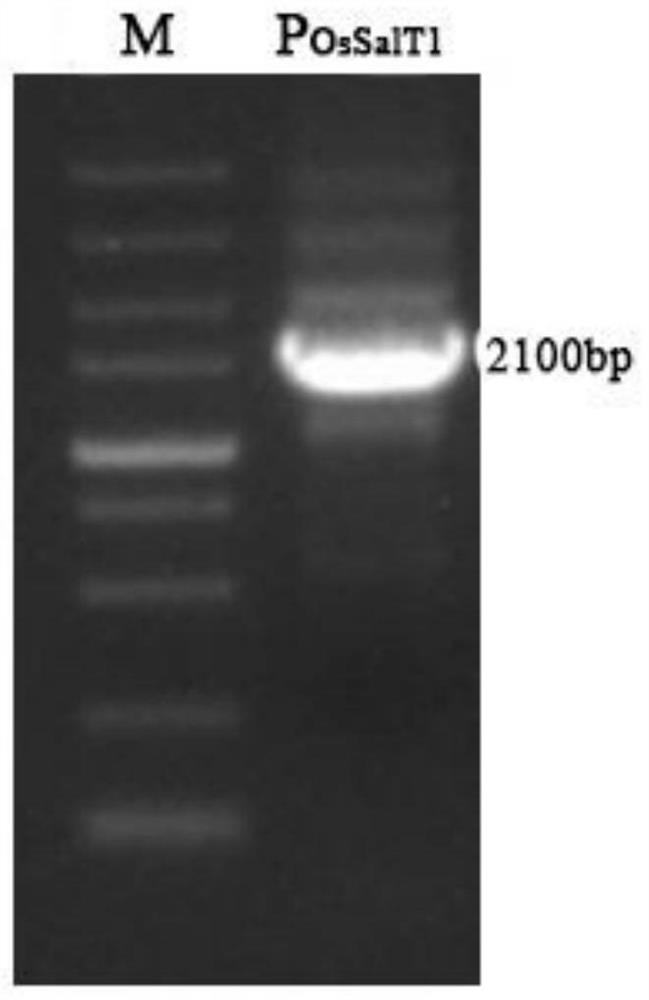A rice stress-inducible promoter p ossalt1 and its application
A promoter and inducible technology, applied in the fields of biotechnology and plant genetic engineering, can solve the problems of ineffective regulation of target genes, unfavorable practical application and promotion, and short plants
- Summary
- Abstract
- Description
- Claims
- Application Information
AI Technical Summary
Problems solved by technology
Method used
Image
Examples
Embodiment 1
[0034] P OsSalT1 Cloning of gene promoters
[0035] according to P OsSalT1The promoter sequence of primer6.0 is used to design primers, obtains a pair of primers, and sequence is as shown in SEQ ID NO:2 and SEQ ID NO:3, as shown in table 2, P1 (underline is PstI restriction site) and P2 ( The underline is the BamHI restriction site) and the restriction site was added in front of the primer. The rice genomic DNA was used as a template for PCR amplification. Amplification conditions: 94°C, 3min; 94°C, 30s, 57°C, 30s, 72°C, 2min10s, 30 cycles; 72°C extension 10min. PCR products were separated by 1% agarose gel electrophoresis figure 1 As shown, UV cut glue. The target fragments were recovered using a gel extraction kit, and connected into the cloning vector pEASY-Blunt for sequencing.
[0036] Primers were designed based on the sequence of ATAF1, and the primer pair sequences are shown in SEQ ID NO:4 and SEQ ID NO:5. As shown in Table 2, A1 (the underline is the restrictio...
Embodiment 2
[0040] P OsSalT1 Construction of promoter expression vector and transformation of Arabidopsis
[0041] The promoter of OsSalT1 was cloned into the plant binary vector pCambia1300-221 to drive the expression of GUS gene. The plasmid map of pCambia1300-221 is as follows figure 2 shown. Digest pCambia1300-221-GUS and the pEASY-Blunt cloning vector containing the promoter fragment with PstI and BamHI, and recover the target fragment and vector fragment. Use T4 DNA ligase to ligate overnight at 22°C to obtain pCambia1300-221-P OsSalT1 -GUS plasmid such as image 3 As shown, then transform Escherichia coli XL1-Blue, extract and identify recombinant plasmids such as Figure 4 shown. Wild-type Arabidopsis was transformed by Agrobacterium-mediated genetic transformation of Arabidopsis inflorescences.
[0042] Digest pCambia1300-221-P with BamHI and SacI OsSalT1 -GUS and the pEASY-Blunt cloning vector containing ATAF1, recovering the target fragment and the vector fragment. Use...
Embodiment 3
[0044] Screening of Transgenic Arabidopsis and Treatment of Abiotic Stress
[0045] Hygromycin was used to screen transgenic Arabidopsis seeds, and the homozygous transgenic strains of the T2 generation were identified. Genome PCR verification results showed that P OsSalT1 The promoter and GUS specific primers amplified bands of 2100bp and 280bp respectively, the results are as follows Figure 6 , indicating that the vector was successfully transferred into the recipient. After abiotic stress (drought, low temperature, high salt) treatment and histochemical staining analysis results are as follows Figure 7 shown. Transplant Arabidopsis thaliana cultured in 1 / 2MS solid medium for about 2 weeks into 1 / 2MS liquid medium for 48 hours. Part of the seedlings were treated with 300mmol / L NaCl medium for 4 hours with high salt; part of the seedlings were placed on filter paper , simulated drought treatment for 4h; some seedlings were treated with 100μmol / LSA medium for 4h; some seed...
PUM
 Login to View More
Login to View More Abstract
Description
Claims
Application Information
 Login to View More
Login to View More - R&D
- Intellectual Property
- Life Sciences
- Materials
- Tech Scout
- Unparalleled Data Quality
- Higher Quality Content
- 60% Fewer Hallucinations
Browse by: Latest US Patents, China's latest patents, Technical Efficacy Thesaurus, Application Domain, Technology Topic, Popular Technical Reports.
© 2025 PatSnap. All rights reserved.Legal|Privacy policy|Modern Slavery Act Transparency Statement|Sitemap|About US| Contact US: help@patsnap.com



